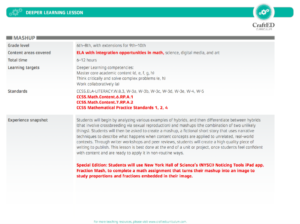“There’s an app for that.”
If you haven’t checked out New York Hall of Science’s suite of apps: Noticing Tools, do so NOW! These apps are a cool way to engage students with the world immediately surrounding them and beyond, by noticing the ways in which math and science are around them every day. Need ideas for how to implement these apps in your classroom next year? Have no fear, NYSCI’s got you covered with searchable lesson plans by content area, standard and grade level.
Getting to Deeper Learning
These ed tech tools provide a wonderful vehicle for deeper learning. What do we mean by deeper learning? Read Hewlett’s Deeper Learning Competencies and watch this video.

Oh the Possibilities!
If you are committed to deeper learning and interested in using Noticing Tools in your classroom, here are a few ideas from CraftED for creating a robust learning experience:
- Take an existing task and build it out into a project. “Recreate a Scene” and “Redesign Your Room” are great starting points, with a ton of potential for turning them into a larger project.
- Use these tools as a scaffold for specific skills or a benchmark assignment/assessment inside a larger project.
- Modify and embellish the finalized graphics for these activities to become a final product for a project. Bonus: align it to VAPA standards to integrate the arts and put the A in STEAM!
- Use the work produced by students in these activities as data to support a claim in an ELA research report.
- Need an example of the above? Check out this strategy, a special edition of CraftED’s Mash-Up lesson made just for NYSCI friends.
If you have more questions or ideas to share, comment on this blog post or check out our post on NYSCI’s teacher forum.
